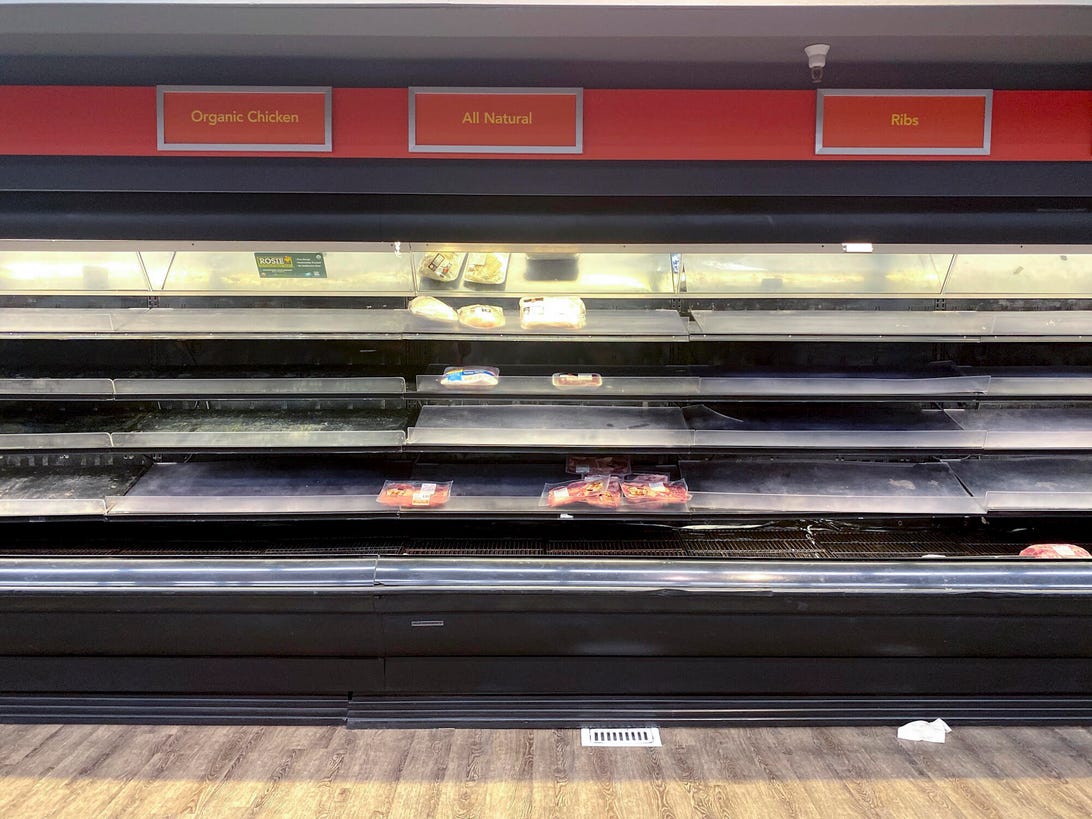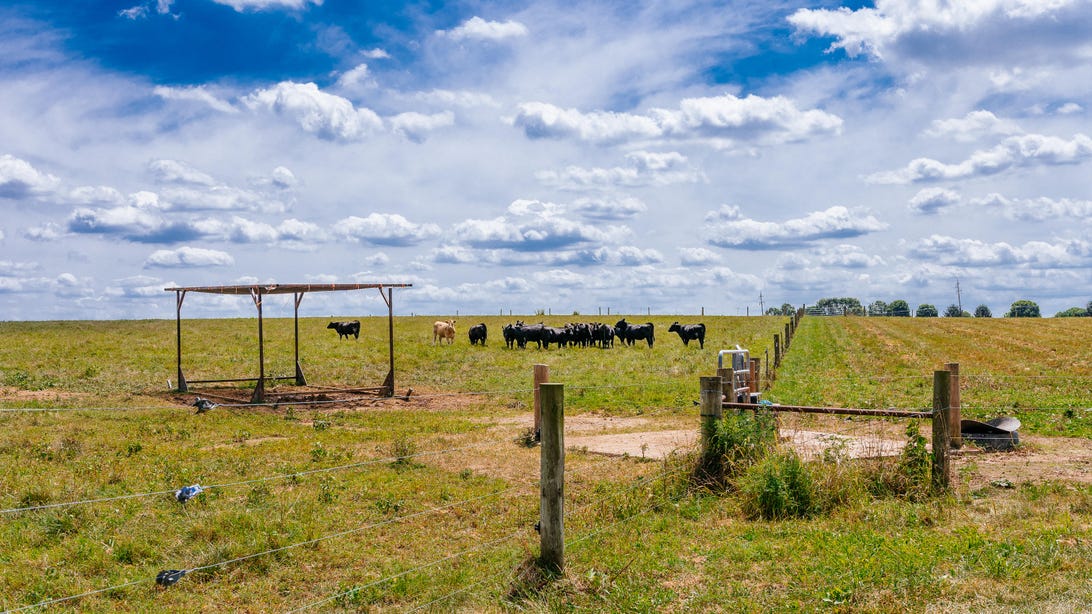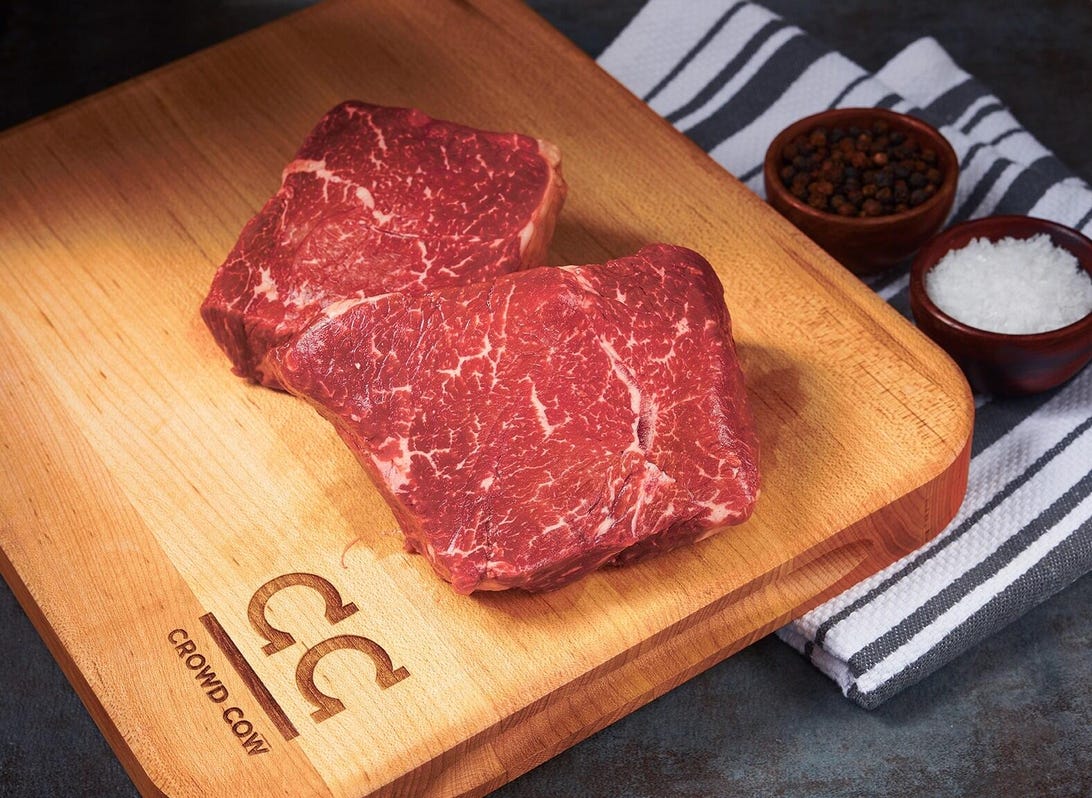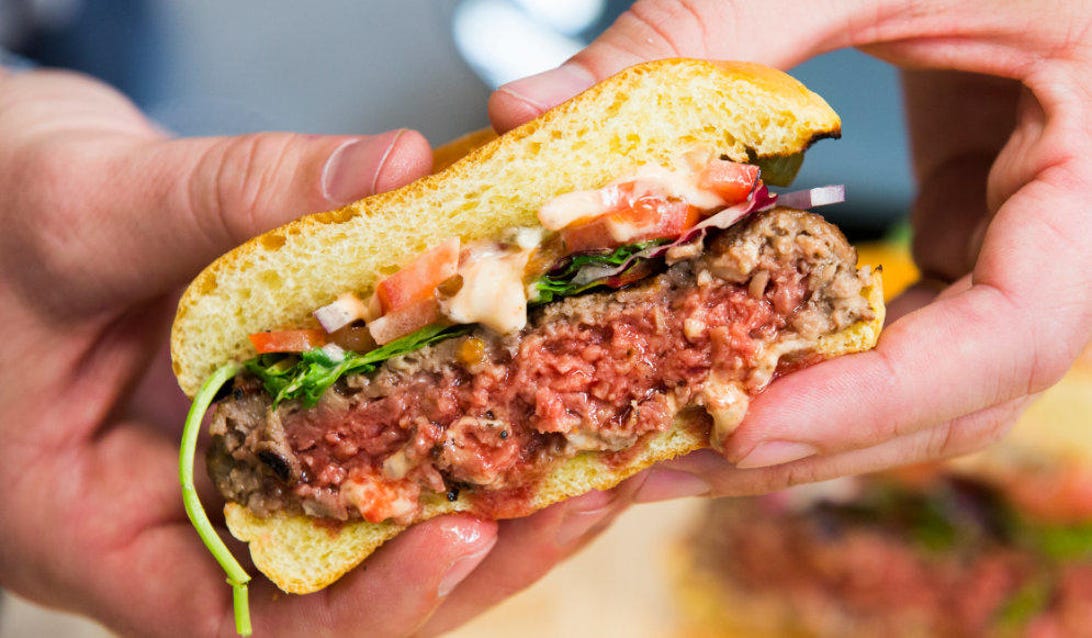When the Price of Beef Goes Up Consumers Switch to Pork and Chicken This Demonstrates
For the most up-to-date news and information about the coronavirus pandemic, visit the WHO and CDC websites.
When the coronavirus pandemic began shutting downwardly meat processing plants beyond the U.s.a. and Canada, concerns over a meat shortage surged. Would shelves empty and prices skyrocket for months to come? Now, as facilities begin to reopen, nosotros have a few more than answers, and many more questions.
Nosotros'll talk most the current situation as we know it, the adaptations inside packing facilities that could change certain things about meat supply, and how an anticipated 2d wave of coronavirus -- over xx states are now seeing spikes in new cases -- could continue to affect the United states meat supply.
This story is intended to provide an overview of the situation and updates frequently.
Is the meat shortage over?
The respond to this questions is a bit circuitous, and then we'll intermission information technology downwards below -- what is a meat shortage mean, how did the meat supply go affected and could it render.
For now, signs indicate that meat production is back in motion and that supplies may be easier to detect. However, pricing may notwithstanding be afflicted (more than beneath) and there are indicators that the supply could exist interrupted again.
For its role, the Wendy'southward fast-food concatenation indicated that its meat supply is about returned to precoronavirus levels, CNN reported.
Plants are reopening, but there are still problems
Many plants have begun reopening with new protocols in place, like glass dividers betwixt workers, required confront mask utilize and an enforced half-dozen-foot altitude at indoor work stations, according to guidance from the Centers for Disease and Prevention Center. Even so, workers are still concerned about the risk of contracting the coronavirus, Politico reported.
The Centers for Disease Command and Prevention details guidance on how processing plants can promote worker safety, noting that "meat and poultry processing workers oft have prolonged closeness to coworkers (due east.m., for ten-12 hours per shift). Continued contact with potentially infectious individuals increases the risk of SARS-CoV-2 manual."
Meatpacking employees aren't the simply ones at loftier risk for infection. The coronavirus is also spreading among people who pack fruit and vegetables, Reuters reported.
Some meatpacking facilities may feel less efficiency and production with the new safe measures in identify, which could still have an impact on the total amount of meat being processed and delivered to restaurants and grocery stores.
How have meatpacking facilities been affected by the coronavirus?
About 5,000 coronavirus cases and twenty deaths throughout 115 meat and poultry processing plants were reported in Apr, the Centers for Disease Control and Prevention said, adding that the typical close working weather condition in these types of facilities pose a significant risk for transmitting COVID-nineteen. Since April, no new numbers have been reported to the CDC, the New York Times reported, so it'south unclear how many cases there are to date. The virus is spread through coughs, sneezes, saliva and even vaporized breath.
Many processing facilities have reopened and are working close to normal, according to Beef Fundamental. Nonetheless, workers are concerned about their condom. For instance, a JBS plant in Utah is remaining open after well-nigh 300 workers were found to have the virus.
President Trump signed an executive lodge in April for plants to reopen, but not all complied, amid the fear of the virus' spread. For example, workers in Utah started protesting confronting a meatpacking establish in June over safety concerns.
Other animal processing facilities accept shut their doors as needed, like Bristol Seafood's Portland Fish Pier plant that airtight for ii days in May later some employees tested positive for the coronavirus. Continued outbreaks, or even a second moving ridge of coronavirus, could crusade future closures.

Meat prices are on the rise.
Tyler Lizenby/CNETHow are meat costs affected?
The cost of meat products similar craven, beef and pork, have been on the rise. Staples like ground beef are still seeing higher prices, the Wall Street Periodical reported. Business organization Insider reports that beef prices were 15.vi% college in the last week of May than they were the previous year.
At the height of the meat processing closures, stores began raising the prices of meat and other grocery items, likewise, as a consequence of the forces of supply and demand. For instance, eggs, milk and other dairy products became more expensive.
Did coronavirus cause a meat shortage?
The answer is yes and no. At the offset of the outbreak, farmers even so had hogs, cattle and chickens, simply the coronavirus disrupted the usual supply chain to make the meat less readily available.
Jim Monroe, the Assistant VP of Communications for the National Pork Producers Council (NPPC) arrangement told CNET that there'southward not a pork shortage, and "the consequence is on the farms where hogs are backed upward due to COVID-related meatpacking plant disruptions." He said "since the Defense Production Act was implemented, which prioritized the continuity of packing constitute operations, the state of affairs has improved."
The outcome was, and continues to be, that facilities can't process meat at the same rate when factories are closed or accommodate fewer employees in line with safe guidance. Every bit a result, farmers with large pork operations, for example, had to cull their hogs, causing food waste material.
Farmers in North Carolina besides euthanized i.5 million chickens. The US Cattlemen's Association noted in a letter of the alphabet to congressional agriculture leaders that the cattle industry had shown $14.6 billion in losses.
Another issue is the restriction on smaller meat processing plants that aren't allowed to supply grocery stores, restaurants, schools and hotels, co-ordinate to the Foundation for Economic Education organization. The organization says that the Processing Revival and Intrastate Meat Exemption Act (Prime Act) could help elevator these restrictions, as well as the dependency on large meat processing plants, like Tyson.

The shelves at your store may be empty.
James Martin/CNETIs it safe to eat meat from plants that accept reported employees with COVID-19?
The CDC says that at that place'south currently no bear witness to suggest that coronavirus can be transmitted from food to a person. If you're still concerned, follow the Food and Drug Administration'due south guidelines (PDF) for cooking beef and pork and beef steaks to 145 degrees Fahrenheit and craven to 165 degrees Fahrenheit -- both with resting fourth dimension -- temperatures known to kill leaner and other pathogens.
How much has the meatpacking industry been affected?
NPPC told us that forty% of pork packing plant chapters was idled at one bespeak, but this number is currently down to 12%. The organization said the situation has improved, but at that place's still a backup of hogs -- between ii.5 to three million -- on farms.
Big meat processing plants, similar Tyson Foods, Smithfield Foods, JBS and Perdue Farms have been affected due to institute closings, with plants reopening. Experts told Market Insider that the United states doesn't face a meat shortage, merely rather a labor shortage, referring to the power of good for you workers to safely do their jobs.
For example, Tyson Foods produces approximately 20% of the beef, pork and craven in the US. The Tyson found in Indiana had nearly 900 coronavirus cases at the showtime of May, making upwardly 40% of the workforce at that location. That location produces nineteen% of the pork in the U.s.a.. Some other Tyson plant in Iowa had more than half of the workers exam positive for the coronavirus. That establish lone processes around xix,500 hogs per day, which amounts to 5% of the total production in the US.
JBS, which processes 23% of the cattle in the US, says it will be affected for months due to the coronavirus, as reported past The Wall Street Periodical.
Coronavirus reopenings: How it looks equally lockdowns ease effectually the world
See all photosHow are grocery stores treatment the situation?
Stores may be affected differently across the Us. Many are starting to ease their limits on how much yous tin buy of a certain product, for example 2 or three packages of each type of meat. That could potentially change in response to a 2nd wave of the virus.
How are farmers who send their livestock to these meat plants affected?
In the precoronavirus world, large farming operations would pack upward their cattle and accept them to the meatpacking plants, then off to the butcher. Even so, with the plants slowing down, animate being processing is still reportedly backlogged every bit of the end of May. With some major meatpacking plants airtight downward, similar Tyson, large farming operations across the state are reportedly walking an economic tightrope. Feeding livestock is plush, and with nowhere to send their animals, some had turned to culling their herd.
NPPC, the pork association, told CNET when the hogs get too large, worker safety issues arise and the processing plants tin can't adapt oversized hogs.

Many farmers are having to cull their livestock since they have nowhere to send them.
Tyler Lizenby/CNETAre my independent local farmers afflicted?
In some areas, more people take shifted to ownership meat from independent local farmers. Only those farmers tin only produce so much livestock, and small, local butchers can handle just so many animals at a fourth dimension. At the same time, small farms also sell their animals to large slaughterhouses, leaving them with nowhere to process their livestock when all butchers are full.
Even if more than people than usual are requesting to buy meat direct from farmers, there's notwithstanding a likelihood for delay if the smaller butchers with a limited chapters for processing meat are overwhelmed past the increased demand.
According to a family member from one ranch that CNET spoke to, who asked to remain anonymous, appointments with smaller and more bazaar butchers typically are booked well in advance.
Can I nonetheless go meat from a meat commitment service and from restaurants?
Yes. Most meat delivery services work with independent suppliers to fulfill orders, still, they, likewise, might experience a delay. If you're signing up for a meat delivery box for the first time, we recommend you phone call to ask how they're impacted.
Note that many of these services are more expensive than grocery stores, frequently as a result of selling grass-fed, organic, heirloom or aged meat. For case, a box of steaks at around 76 ounces (or iv.75 pounds) from Crowd Moo-cow will cost you $159. Similar steaks at the grocery store could cost yous effectually $100 or less for the same weight.
Restaurants operate on a unlike supply chain than grocery stores, so it's likely that open restaurants in your expanse will have meat. Some may limit their dishes as a response, or innovate new bill of fare items that reduce the corporeality of beast protein in a given dish. For case, instead of a whole chicken breast with potatoes, a restaurant could potentially offer a pasta-with-chicken dish.

You can however become meat delivered from a service like Crowd Cow.
Crowd CowHow long could a meat shortage last?
It's unclear when factories, restaurants and supplies will return to precoronavirus levels. Some experts suggest it could last the elapsing of the pandemic. Washington Mail service reports that meat shortages could get worse if the workers proceed to become sick.
Information technology'due south possible that a 2d wave of coronavirus cases could cause plants to shut down once again if enough workers become sick, or if the risk to healthy people in the facilities is determined to grow too high.
Are Impossible Foods or Beyond Meat afflicted?
Impossible Foods and Beyond Meat are companies that make establish-based foods every bit an alternative to meat from animals. Their goal is to brand a product that tastes and behaves like ground beefiness and pork when cooked.
An Impossible Foods representative said that then far, its facilities oasis't been affected by the coronavirus, so its products are still available for purchase. The representative noted the superlative ingredient is soy, and therefore the visitor relies on heavy machinery run past a few essential employees while maintaining enforced social distancing.
The companies have actually seen an increase in sales due to the limited supply of meat, according to Vox. The Incommunicable Foods representative said the visitor started the yr out in 150 grocery stores, and now information technology's in about 3,000 stores today.
Impossible Foods is now available for home delivery and you tin can place your gild on buy.impossiblefoods.com. Across Meat's website can assist consumers find nearby grocery stores that sell their products, but the constitute-based beef and pork aren't available for post club at this time.

Yous tin can still order constitute-based meat.
Incommunicable FoodsHow much protein is recommended per person per day?
A USDA report from 2018 indicated that Americans eat x ounces of meat per solar day, which is effectually 22% college than the recommended amount, depending on how much you weigh and how active you lot are.
The corporeality of poly peptide required for each person varies depending on how much they weigh and the amount of exercise they get each day. USDA says the recommended dietary assart for one twenty-four hour period is 0.eight grams of protein per kilogram of torso weight (or about 3.vi grams per 10 pounds). Yous can calculate your recommended poly peptide intake hither.
What tin I eat for poly peptide instead of meat?
If you find that meat is hard to come by in your expanse, here are several sources of poly peptide you tin can plow to instead:
- Eggs: vi grams of protein per large boiled egg.
- Fish: 13 grams of poly peptide per 3.25 oz. fillet.
- Beans: One cup of boiled white beans has 8 grams of protein.
- Almonds: 1 ounce has 11 grams of protein.
- Yogurt: 8.5 grams of poly peptide per loving cup.
- Quinoa: One cup of cooked quinoa has viii.14 grams of protein.
- Here are some more poly peptide snack options.
If you can't discover meat in your local shop, you can still guild information technology online. Hither are some of the best meat delivery services, every bit well as how to get alcohol, wine and beer delivered to your door and the best meal kit delivery services.

Watch this: Vaccines, antibody tests, treatments: The science of...
The information contained in this article is for educational and advisory purposes only and is not intended as health or medical advice. Always consult a physician or other qualified health provider regarding whatsoever questions you may have about a medical status or health objectives.
Source: https://www.cnet.com/health/is-there-still-a-meat-shortage-the-current-situation-with-chicken-beef-pork-prices-and-supply/
0 Response to "When the Price of Beef Goes Up Consumers Switch to Pork and Chicken This Demonstrates"
Post a Comment